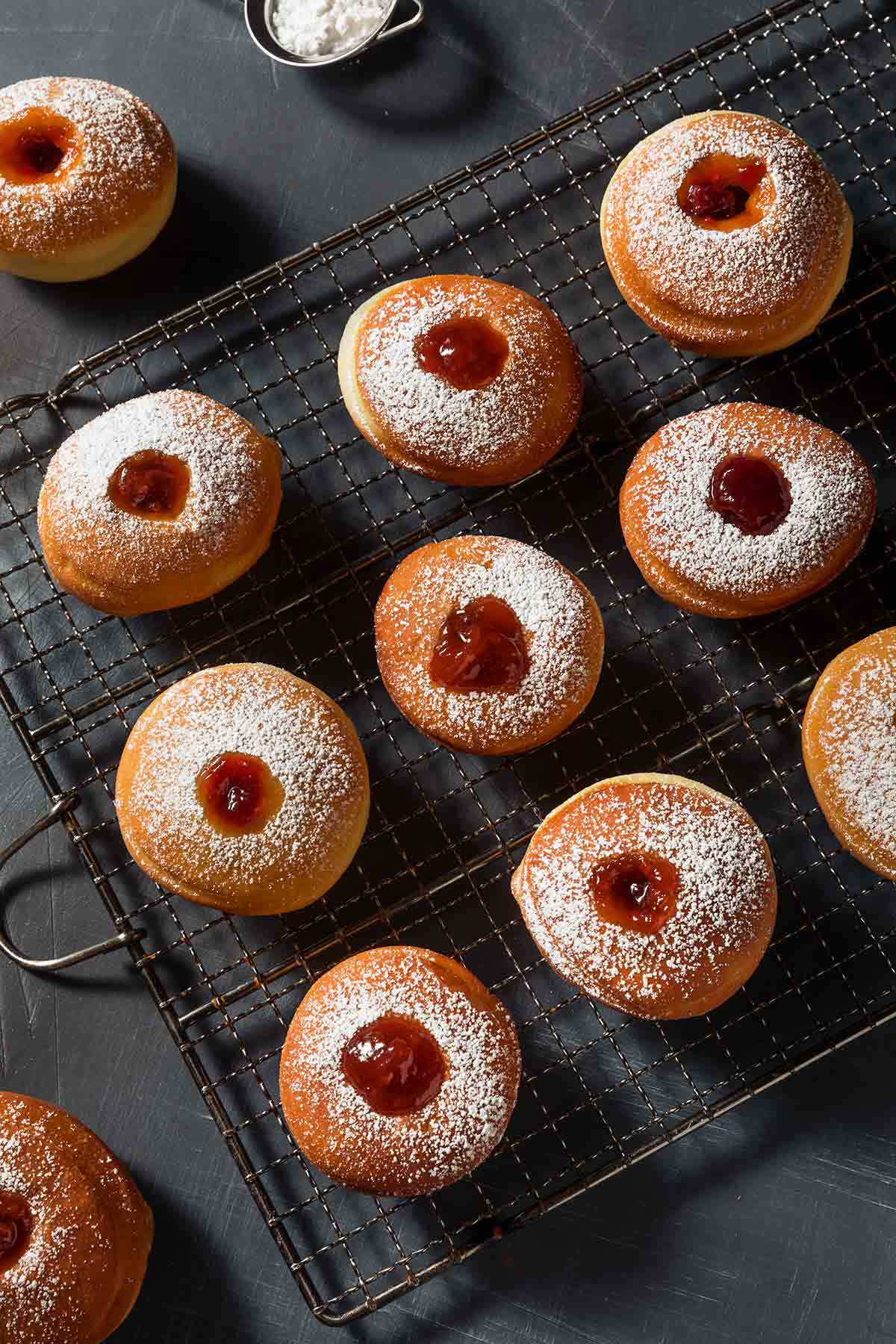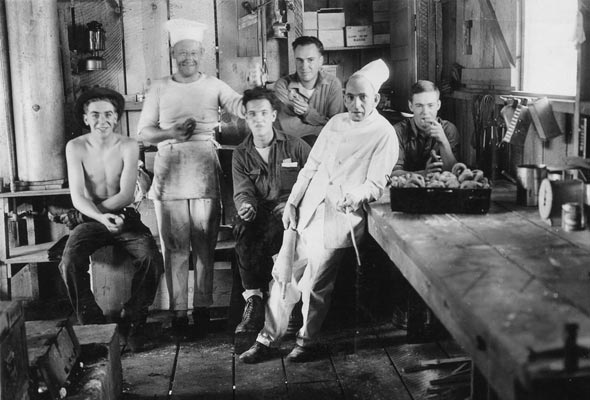
Sufganiyah is a jelly doughnut. Origin: Germany
Other names:
Austria: krapfen
France: boule de Berlin
Germany: Berlinerkrapfen, Berlinerpfannkuchen, Berliners, gefüllte krapfen, Pfannkuchen
Italy: krafen
Poland: paczka, paczki
Portugal; sonhos
Russia: ponchiki, pyshki
Yiddish: ponchik, pontshke
In 1485, the cookbook Kuchenmeisterei (Mastery of the Kitchen) was published in Nuremberg, Germany. In 1532, it was translated into Polish as Kuchmistrzostwo. Besides serving as a resource for postmedieval central European cooking and being one of the first cookbooks to be run off Johannes Gutenberg‘s revolutionary printing press, this tome contained what was then a revolutionary recipe: the first record of a jelly doughnut, “Gefüllte Krapfen.” This early version consisted of a bit of jam sandwiched between two rounds of yeast bread dough and deep-fried in lard. Whether the anonymous author actually invented the idea or recounted a new practice, the concept of filling a doughnut with jam spread across the globe.

Although most modern versions of doughnuts have a sweet interior, the original filled doughnuts were primarily packed with meat, fish, mushrooms, cheese, or other savory mixtures. At that time, sugar was still very expensive and rare in Germany, so savory dishes were much more practical.

In the sixteenth century, the price of sugar fell with the introduction of Caribbean sugar plantations. Soon sugar and, in turn, fruit preserves proliferated in Europe. Within a century of the jelly doughnut’s initial appearance in Germany, every northern European country from Denmark to Russia had adopted the pastry, although it was still a rare treat generally associated with specific holidays. Much later, someone in Germany invented a metal pastry syringe with which to inject jelly into already fried doughnuts, making the treat much easier and neater, and in the twentieth century, machines were developed to inject doughnuts in mass production.
Since at least the early 1800s, Germans had called jelly doughnuts simply Berliners. According to a German anecdote, in 1756 a patriotic baker from Berlin was turned down as unfit for Prussian military service, but allowed to remain as a field baker for the regiment. Because armies in the field had no access to ovens, he began frying doughnuts over an open fire, which the soldiers began calling after the baker’s home, Berliners. The term soon became narrowed to denote only filled krapfen. Thus technically John F. Kennedy’s famous declaration at the Berlin Wall, “Ich bin ein Berliner,” means “I am a jelly doughnut.”
By the end of the century, jelly doughnuts were also called Bismarcken, after Chancellor Otto von Bismarck. Due to the large number of central European immigrants, jelly doughnuts are known as bismarcks in parts of the American Upper Midwest, in Alberta and Saskatchewan in Canada, and even in Boston, Massachusetts. In Manitoba, they are called jam busters. In Britain, they became jam doughnuts. And in general American parlance, they are jelly doughnuts. Poles named jelly doughnuts paczki (flower buds). Polish Jews fried these doughnuts in schmaltz or oil instead of lard and called them ponchiks. In certain areas of Poland, they became the favorite Hanukkah dessert. A doughnut without a filling in Yiddish is a donat. Some Australian Jews, many of whom emigrated from Poland, still refer to jelly doughnuts as ponchiks. Polish immigrants brought ponchiks to Israel, along with the custom of eating them on Hanukkah. In Israel, however, ponchiks soon took the name sufganiyah (sufganiyot plural), from a “spongy dough”mentioned in the Talmud, sofgan and sfogga. The word sphog, meaning “sponge,” is so ancient that there is a question as to whether it was initially of Semitic or Indo- European origin.
In the late 1920s, the Histadrut, the Israeli labor federation, decided to champion the less widespread jelly doughnut as a Hanukkah treat rather than levivot (latkes), because latkes were relatively easy and homemade, while sufganiyot were rather difficult for most home cooks, thereby providing work (preparing, transporting, and selling the doughnuts) for its members. Companies began turning out the doughnuts days or even weeks before Hanukkah, stretching both the amount of work and the period of enjoyment for eating them, although there are those who insist on waiting to eat one until after lighting the first candle. Sufganiyot subsequently emerged as by far the most popular Israeli Hanukkah food. They are sold throughout the eight- day festival at almost every bakery and market, and enjoyed by people in every community and of every religious stripe. In 1995, culinary students at the Hadassah College of Technology in Jerusalem whipped up the world’s largest sufganiyah, weighing 35 pounds, including 5 pounds of jelly, although it paled in comparison to the jelly doughnut listed in the Guinness Book of World Records made in Utica, New York, in 1993 and weighed 1.7 tons.
In 2009, about eighteen million sufganiyot were consumed in the weeks before and during the holiday, or about three doughnuts per Israeli, with the Israeli Defense Force alone purchasing around a half million that year. About 70 percent of all sufganiyot consumed are stuffed with jelly, but a number of contemporary Israeli fillings have become popular, including halva, crème espresso, chocolate truffle, and numerous exotic flavors. Jelly doughnuts in Brazil are commonly filled with dulce de leche (a milky caramel), which recently also became a popular Israeli filling, known as ribat chalav in Hebrew. American Jews by and large adopted the sufganiyah, although most tend to stick to the old-fashioned jelly fillings and a confectioners’ sugar dusting.
“The history of the jelly doughnut | sufganiyot” excerpted from Encyclopedia of Jewish Food | © 2010 Gil Marks.








